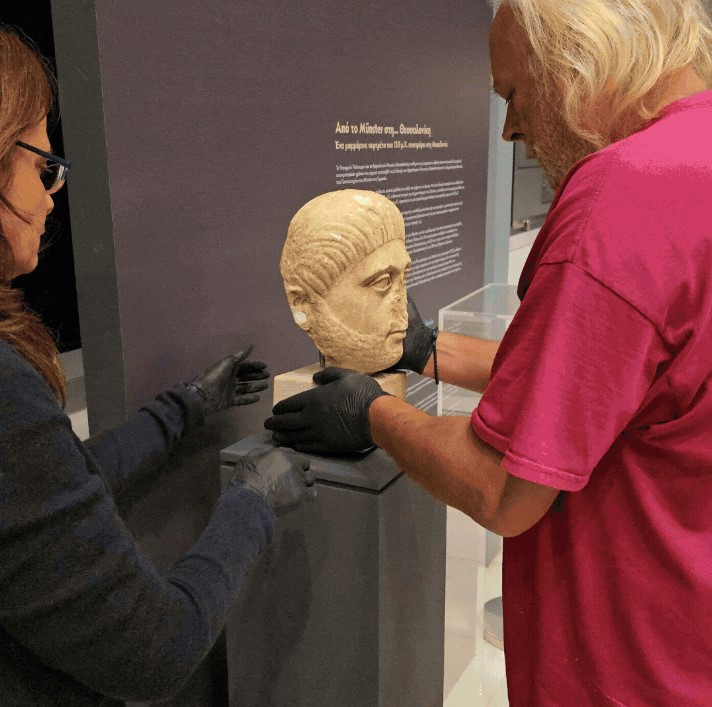The head is temporarily displayed in the foyer of the Archaeological Museum of Thessaloniki, and will then be included in its permanent exhibition.
The figure of a bearded man welcomes visitors to the Archaeological Museum of Thessaloniki and “narrates” the story of the centuries of his life, from 150 AD. approximately, until the very recent one. It is a marble male head from Roman times, which was returned last month by the Archaeological Museum of the University of Münster, Germany (WWU Münster – Münster University).
Thus, the exhibit highlights, among other things, its modern history, since according to the head of the Directorate of Collections and Exhibitions of the Archaeological Museum of Thessaloniki, Styliana Galinikis, it is at the same time part of the present. “The construction of the objects dates back to a period of the past, but their life continues and is enriched – through exhibitions, actions and studies – also in the present”, he points out to the Athenian Macedonian News Agency.
The results of the survey showed … Thessaloniki
The …suspicious and unclear origin of the specific portrait in the Archaeological Museum of the University of Münster, led the archaeologists of the German Museum to proceed with a thorough investigation, where its Greek origin was established. “It was added to the collection of the Münster Archaeological Museum after a deed of donation by a German couple from Essen in 1989, but we do not know how it ended up in the hands of this couple,” says Ms. Galiniki.
In their attempt to decode the DNA of the marble head, the archaeologists of the University started physicochemical studies, from which it emerged that the marble on which the sculpture was carved comes from the quarries of Thassos. “Furthermore, it represents a type of sculpture of the 2nd century AD period, it has headdress characteristics of the time of Emperor Trajan (98-117 AD) but also features such as the short curly beard, which appears in art around the middle of 2nd century AD, so it dates around 150 AD. It is a typical type that we find in several reliefs in the territory of the Roman Empire, mainly in the east, and the fact that we also have similar examples that come from her wider area of Thessaloniki, strengthens their belief about his Greek origin”, emphasizes the head of the Collections and Exhibitions Department of AMTH.
According to her, the head is part of a burial relief that comes from a cemetery in Thessaloniki or the surrounding area. “There was a larger piece of marble around the figure and it is possible that there were other portraits in the original ancient relief,” he says, while emphasizing that other portraits of this type came from the particular Thassos marble. “So there were several affinities in the typology and in the material, and that’s how the finding of related features came about,” he concludes.
An example to follow is the University of Münster
The initiative of the University of Münster for the repatriation of the find is undoubtedly an excellent example of the fight against the illegal trafficking of cultural goods and their return to their places of origin. “It is a message in favor of the return of cultural heritage works to the soils of the places from which they originate and to their populations. In general, it is a good practice of cooperation in the modern era, where there is often the trade of works of art and antiquities through dark streets, an issue that still concerns us and probably will concern us in the future as well”, says Ms. Galiniki.
In fact, the Archaeological Museum of the University of Münster, Germany, in 2019 had also returned to our country the “Skyphos Louis”, an ancient Greek vase that Spyros Louis received as a gift, after winning first place in the marathon road in the revival Olympic Games of the institution in 1896. Today, the Scythian Louis is exhibited in the Museum of the Ancient Olympics, in Ancient Olympia.
At the reception ceremony of the marble male head from Roman times at the Archaeological Museum of Thessaloniki on November 19, the Minister of Culture Lina Mendoni was present, who had emphasized the special semiological dimension of the issue, as it was not the successful outcome of a claim process, but the Museum voluntarily of the University of Münster, decided to return the head to Greece.
The head is temporarily displayed in the foyer of the Archaeological Museum of Thessaloniki, and will then be included in its permanent exhibition.
Source :Skai
I am Frederick Tuttle, who works in 247 News Agency as an author and mostly cover entertainment news. I have worked in this industry for 10 years and have gained a lot of experience. I am a very hard worker and always strive to get the best out of my work. I am also very passionate about my work and always try to keep up with the latest news and trends.











